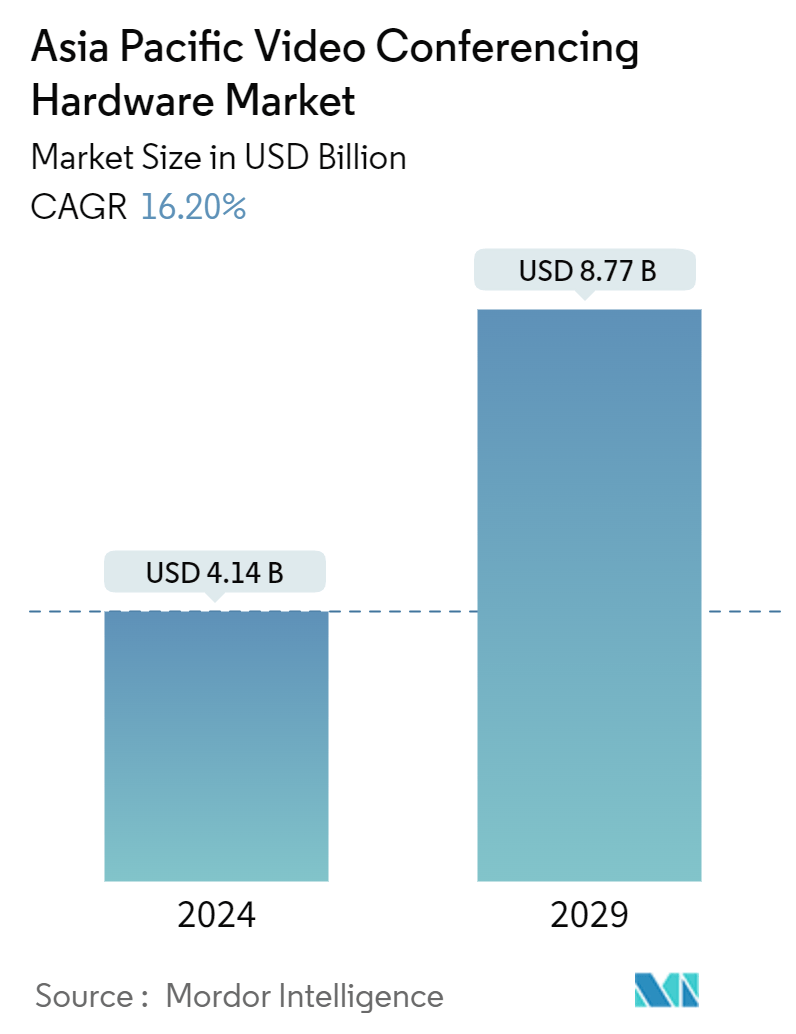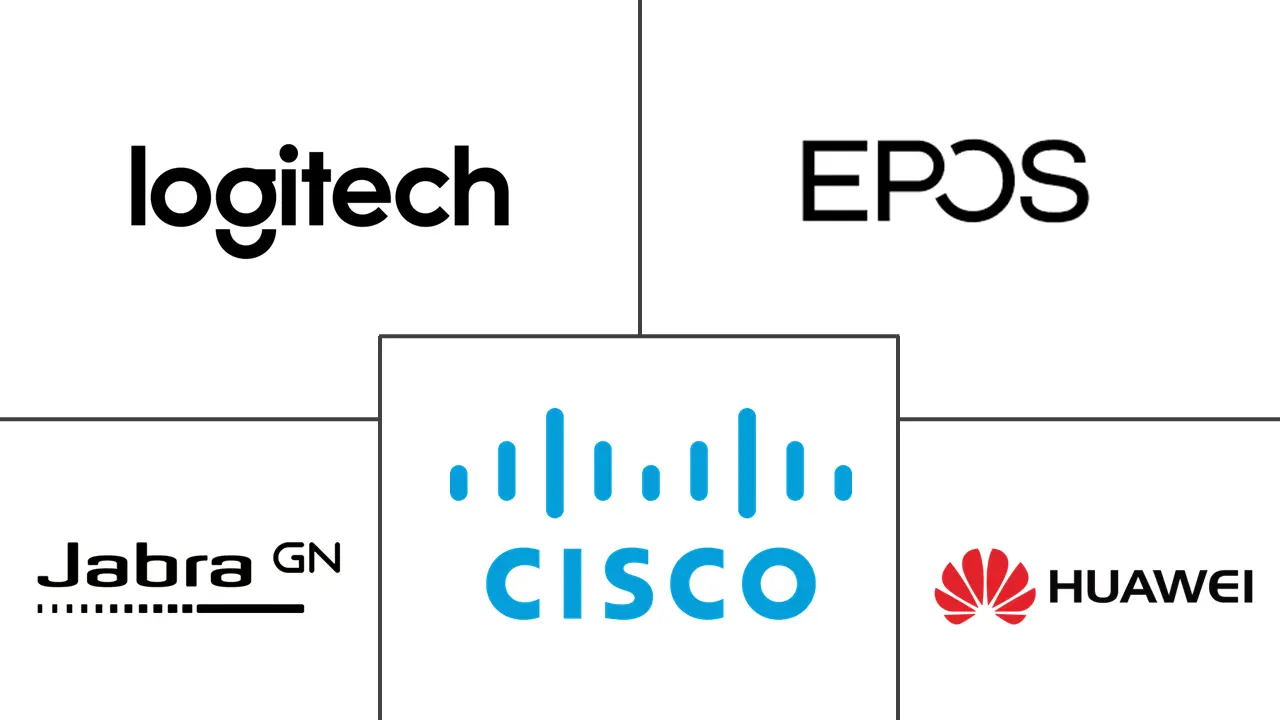Market Size of Asia Pacific Video Conferencing Hardware Industry

| Study Period | 2019 - 2029 |
| Base Year For Estimation | 2023 |
| Market Size (2024) | USD 4.14 Billion |
| Market Size (2029) | USD 8.77 Billion |
| CAGR (2024 - 2029) | 16.20 % |
| Market Concentration | High |
Major Players
*Disclaimer: Major Players sorted in no particular order |
Asia Pacific Video Conferencing Hardware Market Analysis
The Asia Pacific Video Conferencing Hardware Market size is estimated at USD 4.14 billion in 2024, and is expected to reach USD 8.77 billion by 2029, growing at a CAGR of 16.20% during the forecast period (2024-2029).
- Video conferencing has become crucial for businesses of all sizes and sectors, from overseeing remote teams to finalizing international business deals. To remain competitive, firms and organizations must offer clients and staff a reliable solution for high-quality video conferencing, which is crucial for remote work and communication. Having reliable video conferencing equipment can significantly improve the overall standard of the meetings. A high-quality camera that can produce clear and sharp video, even in dimly lit environments, is essential for any conference space. Combined with a top-notch microphone and speaker, it guarantees that everyone participating in the meeting is visible and audible regardless of location.
- Moreover, growing globalization and expanding businesses compel effective communication and collaboration tools, driving the demand for video conferencing hardware. The increasing adoption of video conferencing solutions in educational institutions for online learning, virtual classrooms, and remote training programs drives the demand for video conferencing hardware among institutions.
- For instance, in April 2024, according to Logitech company, adopting hybrid work models presents a significant opportunity for India's video conferencing hardware market. Programs like 'Digital India' by the government promote the adoption of technology and establish a solid environment for electronic manufacturers within the country, which will drive growth in the market. Logitech company discussed the future strategies for the Indian market, mentioning that the company's product team regularly engages with customers to gather feedback that shapes the development of video conferencing hardware products.
- The initial investment required for video conferencing hardware, including USB cameras, displays, audio equipment, and networking infrastructure, can be significant for organizations with limited budgets. Moreover, in some remote or underdeveloped areas, adequate internet connectivity, reliable network infrastructure, and sufficient bandwidth may limit the adoption of video conferencing hardware.
- Exchange rate fluctuations and currency volatility can impact the cost of video conferencing hardware imports and exports, affecting the pricing strategies, profit margins, and market competitiveness of vendors operating in the region. Moreover, regulatory policies related to data protection, privacy, cybersecurity, and telecommunications can impact the adoption and deployment of video conferencing hardware solutions, influencing market dynamics and investment decisions.
Asia Pacific Video Conferencing Hardware Industry Segmentation
For market estimation, revenue generated is tracked from the sale of video conferencing hardware offered by different market players for a diverse range of applications. Market trends are evaluated by analyzing investments made in product innovation, diversification, and expansion. Further, advancements in USB cameras, multi control units (MCU), and enterprise headsets are crucial in determining the market's growth.
The Asia-Pacific video conferencing hardware market is segmented by type of hardware (multi control units (MCU), collaboration bars, codec systems, USB cameras, USB-based integrated bars, other bundled kits, and enterprise headsets), end user (institutions and commercial spaces), country (China, India, Japan, and South Korea). The report offers the market size and forecasts for all the above segments in value (USD).
| By Type of Hardware | |
| Multi Control Units (MCU) | |
| Collaboration Bars | |
| Codec Systems | |
| USB Cameras | |
| USB-based Integrated Bars | |
| Other Bundled Kits | |
| Enterprise Headsets |
| By End User | |
| Institutions | |
| Commercial Spaces |
| By Country | |
| China | |
| India | |
| Japan | |
| South Korea |
Asia Pacific Video Conferencing Hardware Market Size Summary
The Asia Pacific video conferencing hardware market is experiencing significant growth, driven by the increasing need for effective communication and collaboration tools across various sectors. As businesses and educational institutions expand their operations and adopt hybrid work models, the demand for high-quality video conferencing solutions is on the rise. This demand is further fueled by government initiatives promoting digitalization and technology adoption, such as India's Digital India program. The market is characterized by the presence of both large and small players, with major companies like Logitech, EPOS, Jabra, Cisco, and Huawei leading the charge. These companies are focusing on expanding their global consumer base through collaborations, partnerships, and the introduction of innovative products.
The market's growth is also supported by advancements in video conferencing technology, which offer enhanced user experiences, reliability, and security. Educational institutions are increasingly leveraging these solutions for online learning and remote training, while businesses seek cost-effective alternatives to traditional in-person meetings. Despite challenges such as high initial investment costs and varying internet connectivity in remote areas, the market is poised for expansion. The competitive landscape is marked by strategic partnerships and technological innovations, such as Cisco's collaboration with NVIDIA to integrate AI and machine learning into hybrid workspaces. These developments underscore the market's potential to transform communication and collaboration across the Asia Pacific region.
Asia Pacific Video Conferencing Hardware Market Size - Table of Contents
-
1. MARKET INSIGHTS
-
1.1 Market Overview
-
1.2 Industry Attractiveness - Porter's Five Forces Analysis
-
1.2.1 Threat of New Entrants
-
1.2.2 Bargaining Power of Buyers/Consumers
-
1.2.3 Bargaining Power of Suppliers
-
1.2.4 Threat of Substitute Products
-
1.2.5 Intensity of Competitive Rivalry
-
-
1.3 Technology Snapshot
-
1.4 Impact of COVID-19 Aftereffects and Other Macroeconomic Factors on the Market
-
-
2. MARKET SEGMENTATION
-
2.1 By Type of Hardware
-
2.1.1 Multi Control Units (MCU)
-
2.1.2 Collaboration Bars
-
2.1.3 Codec Systems
-
2.1.4 USB Cameras
-
2.1.5 USB-based Integrated Bars
-
2.1.6 Other Bundled Kits
-
2.1.7 Enterprise Headsets
-
-
2.2 By End User
-
2.2.1 Institutions
-
2.2.2 Commercial Spaces
-
-
2.3 By Country
-
2.3.1 China
-
2.3.2 India
-
2.3.3 Japan
-
2.3.4 South Korea
-
-
Asia Pacific Video Conferencing Hardware Market Size FAQs
How big is the Asia Pacific Video Conferencing Hardware Market?
The Asia Pacific Video Conferencing Hardware Market size is expected to reach USD 4.14 billion in 2024 and grow at a CAGR of 16.20% to reach USD 8.77 billion by 2029.
What is the current Asia Pacific Video Conferencing Hardware Market size?
In 2024, the Asia Pacific Video Conferencing Hardware Market size is expected to reach USD 4.14 billion.

